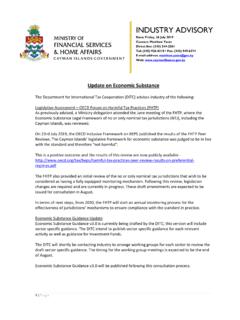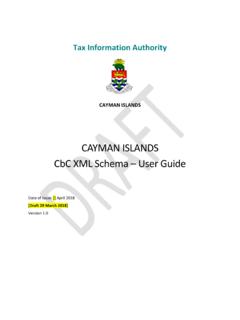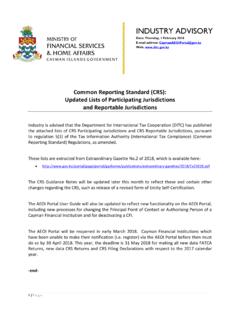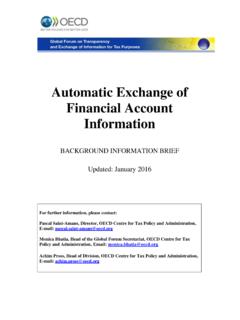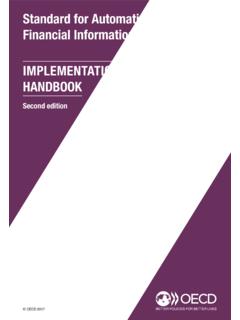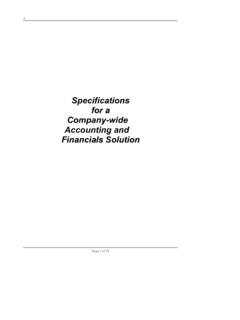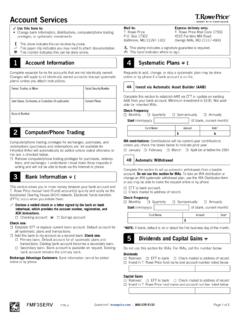Transcription of CAYMAN ISLANDS - TIA
1 Tax Information Authority CAYMAN ISLANDS THE COMMON REPORTING STANDARD FOR automatic exchange OF financial account INFORMATION IN TAX MATTERS Version Guidance Notes These Guidance Notes are issued under regulation 5(2) of the Tax Information Authority (International Tax Compliance) (Common Reporting Standard) Regulations, 2015 by the Tax Information Authority as the Competent Authority for the purposes of the legislation. Date of Issue: 15 March 2018 Department for International Tax Cooperation Website: Contact: Mr. Peter Stafford Email: i Contents I. Overview .. 1 A. General .. 1 B. Core documents .. 1 C. Domestic law .. 2 D. Interpretation .. 3 E. Purpose of these Guidance Notes .. 3 F. The CAYMAN ISLANDS Competent Authority .. 4 G. Entity classification .. 4 II. Obligations of CAYMAN financial Institutions under the CRS Regulations .. 6 A. CRS due diligence and reporting obligations .. 10 B.
2 Accuracy of information .. 10 C. Required written policies and procedures for CAYMAN Reporting financial Institutions .. 10 Examples of written policies and procedures: .. 12 a) No delegation of CRS obligations .. 12 b) Delegation of CRS obligations .. 12 c) Segregated Portfolio Companies, Umbrella Funds and Multi-issuance Entities .. 13 d) Trustee of Trustee Documented Trusts .. 13 D. Registration on the CAYMAN AEOI Portal by notification to the Tax Information Authority 13 1. Required information for every CAYMAN financial Institution .. 14 Trustee Documented Trusts .. 15 E. Reporting to the Tax Information Authority .. 16 1. Timing of reporting on Reportable Accounts and mandatory nil returns .. 16 2. Reporting 16 ii F. CAYMAN AEOI Portal User Guide .. 17 G. Appointment of third parties .. 17 H. Compliance with the TIA s information requirements .. 17 I. Record-keeping .. 18 J. Anti-avoidance .. 19 K. Information requests under the TIA Law.
3 19 III. Key dates under the CRS .. 20 IV. CRS jurisdictions .. 22 A. Participating Jurisdictions .. 22 B. Reportable Jurisdictions .. 22 1. Rules governing tax residence .. 23 2. Tax Identification Number (or functional equivalent) .. 23 C. Confidentiality .. 24 V. Other AEOI regimes .. 25 A. US FATCA .. 25 B. UK CDOT Transition to the CRS .. 26 VI. Guidance on technical issues .. 28 A. General issues .. 28 1. Options under the CRS .. 28 2. Threshold exemption .. 30 3. Due diligence modifications .. 30 4. Residence address test for Lower Value Accounts .. 31 5. Currency translation .. 31 6. Expanded definitions .. 32 7. CRS self-certifications .. 32 a) Template forms .. 32 b) Confirming the validity of self-certifications .. 33 c) False self-certifications .. 34 8. AML/KYC Procedures and due diligence for CRS purposes .. 34 9. Application of New account procedures to Preexisting Accounts relationship manager inquiry.
4 35 iii B. Entity-specific issues .. 36 1. Investment Entities .. 36 a) financial Accounts of investment managers and advisers .. 36 b) CAYMAN financial Institutions that are in liquidation or being wound up .. 36 Dormant or liquidating Investment Entities .. 38 c) Migration ( transfer by continuation) of CAYMAN financial Institutions .. 39 d) Limited Life Debt Investment Entities .. 39 e) Reliance on Model 1 FATCA IGA definition of Investment Entity for purposes of CRS 39 f) Determination of Equity Interest in the case of a widely-held CIV that is a Reporting financial Institution .. 40 2. Segregated Portfolio Companies, Umbrella Funds and Multi-issuance Entities .. 41 3. Passive Non- financial Entities ( NFEs ) .. 41 Identification of Controlling Persons of Passive NFEs with financial Institutions in the chain of legal ownership .. 43 4. Controlling Persons of a trust that is a Passive NFE .. 43 5. Equity Interests of natural persons exercising ultimate effective control of a trust that is a CAYMAN financial Institution.
5 44 6. Non-Participating Jurisdictions Entities .. 45 a) Determination of CRS status of Entities .. 45 b) Determining residence of certain foreign Entities .. 45 7. Holding companies and similar vehicles .. 46 8. CAYMAN ISLANDS retirement and pension funds .. 46 9. Look-through requirement for widely-held CIVs and pension funds in the form of trusts in non-participating jurisdictions .. 47 10. Definition of Active NFE stock regularly traded on an established securities market 48 11. E-money providers qualification as a Depository Institution .. 48 C. account -specific issues .. 48 1. Indirect distributions by a trust .. 48 2. Group Cash Value Insurance Contracts or Group Annuity Contracts .. 49 3. Dormant Depository Accounts are Excluded Accounts .. 50 iv VII. Enforcement .. 51 A. Offences .. 51 B. Administrative penalties .. 54 Appendix 1 Part 1 - The Tax Information Authority (International Tax Compliance) (Common Reporting Standard) Regulations, 2015 Part 2 - The Tax Information Authority (International Tax Compliance) (Common Reporting Standard) (Amendment) Regulations, 2016 Appendix 2 - CRS List of Participating Jurisdictions Appendix 3 CRS List of Reportable Jurisdictions Appendix 4 - Template Entity and Individual Self-Certification Forms CAYMAN ISLANDS CRS Guidance Notes Version Release Date: 15 March 2018 1 I.
6 Overview A. General The Common Reporting Standard ( CRS ) was developed by the Organisation for Economic Co-operation and Development ( OECD ) on the mandate of the G20. It is the global standard for the automatic exchange of financial account information for tax purposes. The CRS builds on the intergovernmental approach adopted by many jurisdictions for the implementation of the United States Foreign account Tax Compliance Act ( FATCA ) and is designed to maximise efficiency and minimise costs. Under the CRS, jurisdictions obtain specified financial account information from their financial Institutions and automatically exchange that information with partner jurisdictions on an annual basis. B. Core documents The standard consists of the following core elements that are relevant for financial Institutions: The Common Reporting Standard that contains the due diligence and reporting rules for financial Institutions.
7 The Commentary on the CRS, which is an integral part of the CRS and is intended to illustrate or interpret its provisions. The OECD has developed a comprehensive automatic exchange Portal that is the principal source for CRS materials and resources. In particular, financial Institutions should consult the following resources which have been issued by the OECD to assist Competent Authorities in the consistent implementation of the Standard itself: CRS Implementation Handbook CRS-related FAQs CAYMAN ISLANDS CRS Guidance Notes Version Release Date: 15 March 2018 2 The legal basis for jurisdictions to exchange information under the CRS is contained in Multilateral or Bilateral Competent Authority Agreements ( CAA ). The most common instrument is the Multilateral Competent Authority Agreement ( MCAA ), to which the CAYMAN ISLANDS is a party. The MCAA contains the rules on the modalities of the exchange between the CAYMAN ISLANDS Competent Authority (the Tax Information Authority) and partner jurisdiction Competent Authorities.
8 It also contains representations on confidentiality, safeguards and the existence of the necessary infrastructure for an effective exchange relationship. C. Domestic law The CRS is implemented in the CAYMAN ISLANDS through The Tax Information Authority Law ( TIA Law ) which provides for all forms of exchange of information for tax purposes. The detailed provisions of the CRS itself are in regulations made under the TIA Law and, in particular Schedule 1 of the CRS Regulations which incorporates the wider approach and options under the CRS. The CRS Regulations are The Tax Information Authority (International Tax Compliance) (Common Reporting Standard) Regulations, 2015 as amended by The Tax Information Authority (International Tax Compliance) (Common Reporting Standard) (Amendment) Regulations, 2016. The CRS Regulations came into force on 1 January 2016 save that the 2016 Amendment came into force on the 19 December 2016.
9 A copy of the original 2015 CRS Regulations and its Schedules are available at Part 1 of Appendix 1 and a copy of the 2016 Amendment to the CRS Regulations is available at Part 2 of Appendix 1. Appendix 1 will be updated upon publication of the 2018 Revision of the CRS Regulations. The CRS Regulations were amended to impose appropriate compliance and regulatory obligations on CAYMAN financial Institutions and certain other persons and to set out the enforcement powers of the Tax Information Authority by means of an administrative penalty regime and also through the court system. These obligations are summarised in CAYMAN ISLANDS CRS Guidance Notes Version Release Date: 15 March 2018 3 section II below headed Obligations of CAYMAN financial Institutions under the CRS Regulations . D. Interpretation The CRS Regulations now include several new definitions to assist with interpretation and also converts these terms used in the CRS (exhibited to the CRS Regulations): Term in the CRS Conversion by the CRS Regulations 1.
10 A financial Institution 1. A CAYMAN financial Institution 2. A Reporting financial Institution 2. A CAYMAN Reporting financial Institution 3. A reporting period or a calendar year or other appropriate reporting period 3. A calendar year. E. Purpose of these Guidance Notes As the CRS is a global standard, the OECD has developed extensive and comprehensive materials for the consistent application and interpretation of the Standard by all jurisdictions. These Guidance Notes are therefore limited to providing guidance on aspects of the CRS that are particular to CAYMAN and to addressing certain aspects of the CRS Regulations. These Guidance Notes are not intended to replicate the information in the aforementioned OECD documents, which form the core of the Standard and its interpretation subject to the CRS Regulations. A financial Institution must apply the CAYMAN CRS Regulations in force at the time, with reference to the commentary on the Common Reporting Standard and these Guidance Notes.
